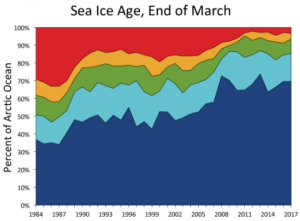"Sea ice age is a proxy for ice thickness, with older ice generally meaning thicker ice. Though ice can pile up into rubble fields when the motion of the ice pushes up against the coast or thicker ice, level ice generally increases in thickness as it ages through more winter freeze cycles. Thus, ice age is a reasonable indicator of the sea ice thickness.

At the end of March, ice age data show only a small remaining coverage of old (5+ years) ice. Since 2011, the oldest ice has comprised less than 5 percent of the total ice cover. During the mid-1980s, such ice made up nearly a third of the ice. [...] Most of the third year ice is between Fram Strait and the pole, which means it is likely to exit the Arctic Ocean during the coming months."
The above text is taken from the April report from the National Snow and Ice Data Center (NSIDC). Follow the link to read the full article.
